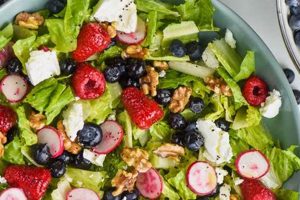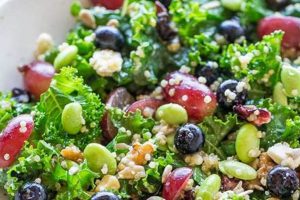A chilled dish featuring cooked lobster meat combined with mayonnaise-based dressing, often incorporating celery, onion, and seasonings, served nestled in a soft roll or hot dog bun constitutes this culinary creation. Variations can include the addition of herbs like dill or tarragon, lemon juice, or other spices. A simple, elegant presentation might involve lettuce lining the bun, while more elaborate versions could incorporate avocado or bacon.
This dish offers a delightful combination of textures and flavors, balancing the richness of the lobster with the creamy dressing and crisp vegetables. Its popularity stems from its refreshing nature, making it ideal for warmer weather, picnics, or light lunches. Historically, lobster, once considered a food for the working class, became a delicacy, and dishes like this represent an accessible yet elevated way to enjoy it. The simplicity of preparation combined with high-quality ingredients contributes to its enduring appeal.
This discussion will explore the nuances of preparing this dish, focusing on ingredient selection, techniques for achieving optimal flavor and texture, and variations to suit diverse palates. Further exploration will cover presentation tips, suggested side dishes, and wine pairings.
Tips for Crafting Exceptional Lobster Salad Rolls
Achieving truly exceptional lobster salad rolls involves attention to detail at every stage, from ingredient selection to final assembly. These tips offer guidance for elevating this classic dish.
Tip 1: Prioritize Fresh, High-Quality Lobster: Opting for freshly cooked lobster yields optimal flavor and texture. If using pre-cooked lobster, ensure it’s from a reputable source and handled properly. Frozen lobster meat can be substituted but should be thawed gently and thoroughly.
Tip 2: Gentle Handling is Key: Overmixing lobster meat can result in a tough, rubbery texture. Combine ingredients delicately, ensuring the lobster retains its natural flakiness.
Tip 3: Balance the Dressing: The dressing should complement, not overpower, the lobster. Start with a high-quality mayonnaise base and incorporate seasonings judiciously, tasting and adjusting as needed.
Tip 4: Consider the Bread: A classic New England-style split-top roll is traditional, but other soft breads like brioche or even croissants can provide interesting variations. Lightly toasting the bread adds texture and prevents sogginess.
Tip 5: Elevate with Fresh Herbs: Fresh herbs like dill, tarragon, or chives add brightness and complexity. Incorporate them finely chopped into the lobster salad.
Tip 6: Chill Before Serving: Chilling allows the flavors to meld and enhances the refreshing quality of the dish. Aim for at least 30 minutes of refrigeration before serving.
Tip 7: Mindful Presentation: Thoughtful presentation enhances the dining experience. Line the roll with crisp lettuce, and consider garnishes like a sprinkle of paprika or a lemon wedge.
By focusing on these tips, one can create lobster salad rolls that showcase the delicate sweetness of the lobster while achieving a harmonious balance of flavors and textures.
With these preparations complete, the final step is to savor the fruits of this culinary endeavor.
1. Fresh, High-Quality Lobster
Fresh, high-quality lobster serves as the cornerstone of a successful lobster salad roll recipe. The inherent sweetness and delicate texture of fresh lobster meat are essential for achieving the desired flavor profile. Using inferior or improperly handled lobster can result in a fishy taste, tough texture, and ultimately, a disappointing culinary experience. The impact extends beyond taste; fresh lobster contributes to the overall quality and perceived value of the dish. For instance, a lobster salad roll featuring freshly cooked, locally sourced lobster elevates the dish, justifying a premium price point compared to one using frozen or pre-packaged lobster meat. The choice reflects a commitment to quality, impacting customer perception and satisfaction.
This emphasis on quality ingredients underscores a broader culinary principle: the final product is only as good as its components. Compromising on lobster quality diminishes the potential of the entire dish, regardless of other efforts. Consider the difference between a lobster salad roll made with freshly steamed, sweet lobster meat versus one made with previously frozen, potentially bland lobster. The former offers a vibrant, flavorful experience, while the latter risks a flat, uninspired taste. This distinction highlights the practical significance of prioritizing fresh, high-quality lobster.
In conclusion, the connection between fresh, high-quality lobster and a successful lobster salad roll recipe is undeniable. Prioritizing this key ingredient not only elevates the taste and texture but also contributes to the overall dining experience. While cost considerations might tempt some to compromise, the resulting difference in quality underscores the importance of investing in the best possible ingredients. This principle applies not just to lobster salad rolls, but to any dish where ingredient quality significantly impacts the final outcome.
2. Balanced, Flavorful Dressing
A balanced, flavorful dressing is paramount to a successful lobster salad roll recipe. The dressing serves as a unifying element, binding the lobster meat and other ingredients while contributing significantly to the overall flavor profile. An imbalanced dressing can easily overpower the delicate sweetness of the lobster, resulting in a dish that lacks nuance and complexity. Conversely, a bland or watery dressing fails to enhance the lobster’s flavor, leading to a disappointing culinary experience. The balance lies in achieving a dressing that complements the lobster without masking its inherent qualities. For instance, a heavy, overly mayonnaise-based dressing can obscure the lobster’s taste, while a dressing overly reliant on citrus can create an excessively acidic profile. A balanced dressing, perhaps a light aioli with a hint of lemon and fresh herbs, enhances the lobster’s natural sweetness without overpowering it.
The practical significance of this balance lies in the interplay of flavors and textures. A well-executed dressing contributes not only to the taste but also to the mouthfeel of the lobster salad. A creamy dressing, for example, can create a luxurious texture that contrasts pleasantly with the chunkiness of the lobster and the crispness of any added vegetables. This textural interplay adds depth and interest to the dish. Consider a classic lobster salad roll: the tender lobster meat, bound by a lightly creamy dressing with a touch of acidity and punctuated by the crunch of celery, offers a multi-sensory experience. The dressing, far from being a mere afterthought, plays a crucial role in orchestrating this symphony of flavors and textures.
In summary, the role of a balanced, flavorful dressing in a lobster salad roll recipe cannot be overstated. It is not simply a matter of adding moisture or binding ingredients; it is about enhancing and elevating the lobster’s natural flavors. Achieving this balance requires careful consideration of ingredients and proportions. The dressing should complement, not compete with, the lobster. This understanding is fundamental to crafting a truly exceptional lobster salad roll, transforming it from a simple sandwich into a culinary delight.
3. Appropriate Bread Choice
Appropriate bread choice significantly impacts the overall success of a lobster salad roll recipe. The bread serves as both a structural foundation and a flavor component, influencing the final product’s texture, taste, and overall eating experience. An unsuitable bread choice can detract from the delicate lobster salad, leading to structural failure, flavor clashes, or an unbalanced textural profile. The ideal bread should complement the lobster salad, providing a supportive yet unobtrusive backdrop that enhances, rather than overshadows, the primary ingredients. For example, a dense, sourdough loaf would overwhelm the delicate lobster salad, while a flimsy, thin-sliced white bread might disintegrate under the weight and moisture of the filling. A classic New England split-top roll, with its soft texture and slightly sweet flavor, provides an ideal balance, offering structural integrity without competing with the lobster salad.
The practical implications of bread choice extend beyond simple structural considerations. The bread’s flavor profile interacts directly with the lobster salad, creating a synergistic or clashing effect. A buttery brioche bun, for instance, can complement the richness of the lobster and mayonnaise, while a seeded multigrain roll might introduce conflicting flavors. Texture also plays a crucial role. A crisp, toasted roll offers a pleasing contrast to the creamy lobster salad, while a soft, untoasted roll provides a more homogenous, melt-in-your-mouth experience. The choice depends on the desired outcome and individual preferences. Consider a lobster salad featuring fresh tarragon and lemon zest; a toasted brioche bun complements the bright, citrusy notes, while a soft, buttery roll might enhance the richness of the lobster. These subtle yet crucial differences demonstrate the significant impact of bread selection.
In conclusion, selecting the appropriate bread for a lobster salad roll is crucial for achieving the desired balance of flavors, textures, and structural integrity. The bread should neither dominate nor disappear but rather serve as a supportive partner to the lobster salad. Understanding the interplay between bread choice and the overall composition of the dish allows for informed decisions, ensuring a satisfying and well-balanced culinary experience. This seemingly simple choice, therefore, becomes a critical element in crafting a truly exceptional lobster salad roll.
4. Complementary Ingredients
Complementary ingredients play a vital role in elevating a lobster salad roll recipe from simple to exceptional. These additions, carefully chosen and balanced, enhance the lobster’s inherent sweetness and delicate texture while contributing complexity and depth of flavor. The thoughtful incorporation of complementary ingredients transforms the lobster salad from a mere mixture of components into a harmonious blend, offering a more nuanced and satisfying culinary experience. This synergy stems from the interplay of flavors, textures, and aromas, creating a multi-sensory experience that transcends the sum of its parts. Consider the classic pairing of celery and lobster salad; the celery’s crisp texture and slightly vegetal flavor provide a refreshing counterpoint to the richness of the lobster and the creamy dressing. Similarly, the subtle anise notes of tarragon or the bright acidity of lemon zest can lift and brighten the lobster’s flavor, adding another layer of complexity.
The practical significance of selecting appropriate complementary ingredients lies in achieving a balanced and harmonious flavor profile. Overly assertive additions can easily overpower the delicate lobster, while bland or uninspired choices fail to enhance the overall experience. This balance requires careful consideration of flavor affinities and textural contrasts. For example, the peppery bite of red onion might clash with the lobster’s sweetness, whereas the mild, oniony flavor of chives offers a more harmonious pairing. Similarly, the addition of crunchy diced cucumber or water chestnuts can introduce a welcome textural contrast, enhancing the overall enjoyment of the dish. These seemingly minor decisions exert a considerable influence on the final product, demonstrating the practical importance of understanding the role of complementary ingredients.
In summary, the strategic use of complementary ingredients represents a crucial element in crafting a superior lobster salad roll. These additions contribute not only to the flavor profile but also to the textural complexity and overall appeal of the dish. Careful consideration of flavor pairings and textural contrasts is essential for achieving a balanced and harmonious result. The interplay between the lobster, the dressing, and the complementary ingredients creates a synergistic effect, transforming a simple combination of components into a truly exceptional culinary creation. Mastery of this principle allows for greater control over the final product, enabling one to tailor the lobster salad roll recipe to specific preferences and desired outcomes.
5. Proper Chilling and Serving
Proper chilling and serving techniques are essential for maximizing the enjoyment of a lobster salad roll. Temperature and presentation significantly influence the perception of flavor, texture, and overall quality. These final steps, though seemingly simple, are crucial for ensuring that the carefully selected ingredients and thoughtfully prepared lobster salad reach their full potential. Neglecting these considerations can compromise the overall dining experience, diminishing the impact of even the highest-quality ingredients.
- Temperature Management
Chilling the lobster salad allows the flavors to meld and intensifies the refreshing quality of the dish. Insufficient chilling can result in a bland, lukewarm mixture, while excessive chilling can negatively impact the texture, making the lobster meat tough. Ideally, the lobster salad should be chilled for at least 30 minutes but no longer than two hours to achieve optimal flavor and texture. Serving temperature also plays a critical role; a chilled roll complements the cool lobster salad, enhancing the overall refreshing experience. Conversely, a warm or room-temperature roll can create a jarring contrast, diminishing the intended effect.
- Presentation and Garnishing
Visual appeal enhances the dining experience, influencing perceived flavor and enjoyment. A thoughtfully presented lobster salad roll elevates the dish from a simple sandwich to a more refined culinary creation. Consider lining the roll with crisp lettuce leaves not only for aesthetic appeal but also to provide a barrier against sogginess. Garnishes, such as a sprinkle of paprika, a sprig of fresh dill, or a lemon wedge, add visual interest and subtle flavor enhancements. The presentation should complement the lobster salad, emphasizing its freshness and quality. For example, a simple, elegant presentation on a white plate with a small garnish highlights the lobster salad’s vibrancy, while an overly elaborate presentation might distract from the main attraction.
- Serving Vessels and Accompaniments
The choice of serving vessel and accompanying sides can further enhance the enjoyment of a lobster salad roll. Serving the roll on a classic paper-lined tray evokes a casual, New England-style picnic experience, while a more formal presentation on a china plate elevates the dish for a more refined setting. Side dishes should complement the lobster salad without overwhelming it. Classic choices include potato chips, coleslaw, or a simple green salad. These accompaniments offer contrasting textures and flavors, enhancing the overall dining experience. For instance, the saltiness of potato chips balances the sweetness of the lobster salad, while the tangy acidity of coleslaw provides a refreshing counterpoint.
- Timing and Freshness
Lobster salad rolls are best enjoyed fresh. Prolonged storage can compromise both flavor and texture. Ideally, the lobster salad should be assembled and chilled shortly before serving. If making the salad in advance, store the components separately and combine them just before serving to maintain optimal freshness. The bread should also be fresh, ideally purchased or baked on the day of serving. These considerations ensure that the lobster salad roll is experienced at its peak, maximizing its flavor and textural appeal. Serving a wilted or soggy lobster roll diminishes the enjoyment, regardless of the quality of the ingredients.
By attending to these seemingly minor details of chilling, presentation, and serving, one ensures that the lobster salad roll is experienced at its best. These final steps are crucial for maximizing the enjoyment of this classic dish, elevating it from a simple sandwich to a truly satisfying culinary experience. The combination of optimal temperature, thoughtful presentation, and appropriate accompaniments creates a synergistic effect, showcasing the quality of the ingredients and the care taken in preparation.
Frequently Asked Questions
This section addresses common inquiries regarding lobster salad roll preparation, offering concise and informative responses.
Question 1: What is the best type of lobster to use for lobster salad rolls?
Freshly cooked, live lobster yields optimal flavor and texture. However, pre-cooked or frozen lobster meat can be substituted if fresh lobster is unavailable. When using frozen lobster, ensure it is fully thawed and patted dry before incorporating it into the salad.
Question 2: Can lobster salad rolls be made ahead of time?
While best served fresh, components can be prepared in advance. Store the cooked lobster meat, dressing, and chopped vegetables separately and combine them shortly before serving. This prevents the salad from becoming watery and maintains the integrity of the individual ingredients.
Question 3: What type of bread is traditionally used for lobster salad rolls?
A classic New England split-top roll is the traditional choice. Its soft texture and slightly sweet flavor complement the lobster salad without overpowering it. Other soft breads like brioche or potato rolls can also be used.
Question 4: How can one prevent the bread from becoming soggy?
Lightly toasting the bread before adding the lobster salad creates a barrier against moisture. Additionally, lining the roll with lettuce leaves can further prevent sogginess. Avoid overfilling the roll, as excess moisture from the salad can also contribute to sogginess.
Question 5: What are some common variations on the classic lobster salad roll recipe?
Variations include adding ingredients like avocado, bacon, or different herbs. The dressing can also be customized with the addition of lemon zest, Dijon mustard, or other spices. These variations allow for customization based on individual preferences.
Question 6: How long can lobster salad be stored in the refrigerator?
Lobster salad should ideally be consumed within one to two days of preparation. Store it in an airtight container in the refrigerator to maintain freshness and prevent bacterial growth. Always ensure the lobster salad is kept at a safe temperature below 40F (4C).
Addressing these common questions provides a comprehensive understanding of essential aspects of lobster salad roll preparation. Adherence to these guidelines ensures optimal flavor, texture, and food safety.
The following section will explore variations on the classic lobster salad roll recipe, offering inspiration for culinary exploration and customization.
Lobster Salad Roll Recipe
Exploration of the lobster salad roll recipe reveals a dish reliant on quality ingredients and careful execution. Fresh lobster, a balanced dressing, appropriate bread selection, complementary ingredients, and proper chilling and serving contribute significantly to the final product. Emphasis on ingredient quality, particularly the freshness of the lobster, remains paramount. A well-balanced dressing enhances, rather than masks, the delicate flavor of the lobster. Bread choice impacts both texture and structural integrity, while complementary ingredients contribute complexity and depth. Finally, proper chilling and presentation elevate the dining experience.
Culinary traditions, like the lobster salad roll, offer valuable insights into the interplay of ingredients and technique. Continued exploration of such recipes allows for a deeper appreciation of culinary heritage and the potential for creative adaptation. The seemingly simple lobster salad roll serves as a reminder that even basic dishes can achieve culinary excellence through careful attention to detail and a commitment to quality.






